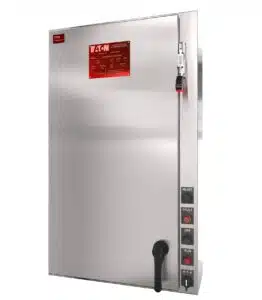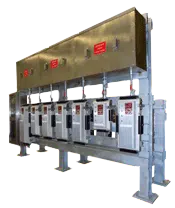
Combination motor starters can be used in an efficient way for containing the motor starter and electrical protection devices within a single enclosure.
Motor starters are designed to provide safety for users to start or stop a motor through an electromechanical switch. It is similar to operating a relay, but it also provides motor overload protection. Combination motor starters can be helpful to provide users with another level of protection. They bring together:
- The control device, also known as the contractor
- Providing motor overload protection which is helpful to prevent motors from overheating
- Protection against short circuits
It has added short circuit protection which enables the start to react against certain faults to protect the motor. A fault can be fatal for your motor or it can damage the motor permanently. Therefore, this protection is helpful to prevent your motor from permanent damage and avoiding costly repairs. The protection against short circuit can be provided with the help of:
- A circuit breaker
- Or a fused disconnect switch
All of these elements are combined within a single enclosure, and it allows for easy installation and access to relevant workers while performing operations during emergency or normal operations.
How Does a Combination Motor Starter Work?
A combination motor starter generally works similarly to the standard motor starters. However, they are able to switch the required amount of current to the motor safely and helps to prevent the motor from drawing a current more than it’s safety parameters.
With the help of short circuit protection available in the combination motor starter, the circuit gets everything it needs for operating with adequate failsafe measures in place. When you are using a combination motor starter and disconnect switch or circuit breaker, you can open all the lines in case of a fault in any phase. It can be helpful for the prevention of single phasing that could lead to voltage imbalance and motor burnout.
A starter can be operated manually or electronically through magnetic components and it is totally dependent on your operational needs.
Manual Combination Motor Starters
Manual combination motor starters are easy to operate. A user just needs to press the button or turn the power rotary knob to switch the connected motor on or off. Then, it operates the mechanical linkages, opening or closing them to start or stop the motor.
Manual starters can be an ideal choice as they offer:
- Safe and efficient operation
- Smaller size making them suitable for different applications
- The initial cost of a manual starter is comparatively low
- Circuit breaker/fused switch to provide an additional failsafe
Magnetic Combination Motor Starters
Magnetic combination motor starters offer electromagnetic operation which is helpful to control them remotely. Therefore, it is ideal for larger-scale operations. However, the motor load connected to the motor start can be turned on/off using a safer voltage usually 120V for your control devices.
There are various types of magnetic combination motor starters having specific configurations within a circuit. Different type of magnetic combination motor starters are:
- Direct-On-Line (DOL) Starters or Direct-Across-The-Line Starter Full Voltage Non-Reversing (FVNR)
- It is a general-purpose starter that comes with a magnetic contactor for connecting the full voltage of the power supply with the motor. They can be used for motors that just need to run at a fixed speed in a single direction.
- Reversing Direct-On-Line (DOL) Starters or Direct-Across-The-Line Starter Full Voltage Reversing (FVR)
- It also comes with the same utility as standard DOL starters but it also has the ability to run forwards and backward. Thus, it is specifically useful for the conveyer-based machinery where directional control is required.
- Star Delta Starters
- It is a reduced voltage motor that is suitable for longer acceleration cycles and operation at a larger scale. It is designed for operating three-phase induction motors and it can switch the windings between delta and start connections for starting the motor.
- Soft Starters
- They are normally used for controlling AC electric motors. They are helpful in reducing the torque and load during the start-up phase and electrical current surges.
Why Do You Need a Combination Motor Starter?
Using a combination motor starter can provide you with additional peace of mind regarding your motor circuit security. However, standard motor starters are capable of performing the same process. Still, the benefits of a combination motor starter can be helpful to provide enhanced circuit protection devices that are combined within a single enclosure.
The combination motor starter comes with either a circuit breaker or fused disconnect switch and it offers the built-in capability to protect the motor against a short circuit. So it does not only protect your motor from burning out due to any fault in current, it also provides everything that a circuit requires according to Article 430 of the National Electric Code.
With the help of resettable circuit protection, you will be able to reset your motor quickly and start it once the fault is cleared. This means you will be able to minimize the downtime of the motor and get it working again faster.
There are different uses of combination motor starter:
- Fans
- Heat Pumps
- Water Pumps
- Compressors
- Ventilators
- Conveyor Belts
- Blowers
Why Buy Combination Motor Starters from Spike Electric?
We are one of the largest stocking manufacturers in North America when it comes to combination motor starter components. We offer safe, reliable and efficient energy solutions.
Do not hesitate to stay in touch with us if you have any questions.
Written by: Cole Attaway
Cole Attaway is the founder and CEO of Spike Electric Controls. Spike's mission is to improve the accessibility and delivery of industrial electrical gear for clients nationwide. Spike solutions result in reduced unplanned downtime, less overtime, and greater operational efficiencies.


